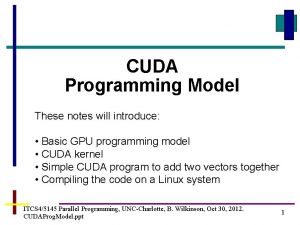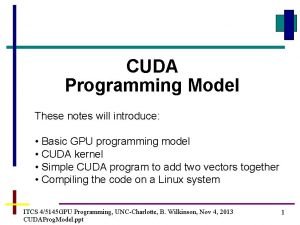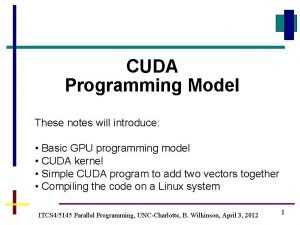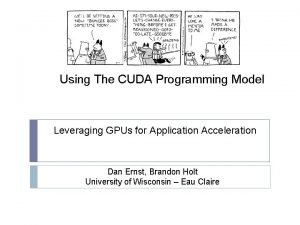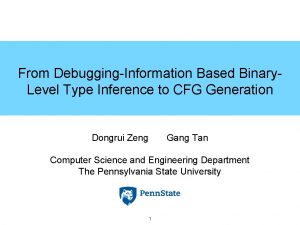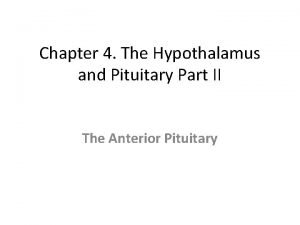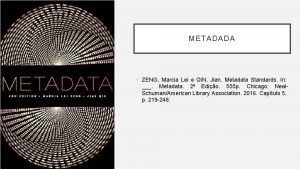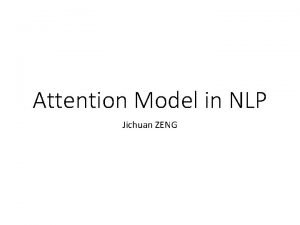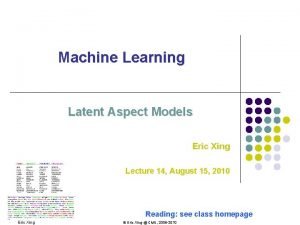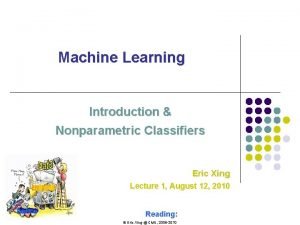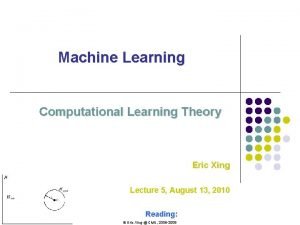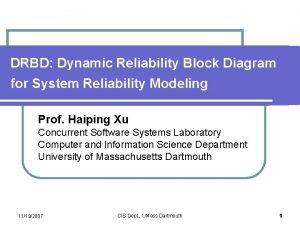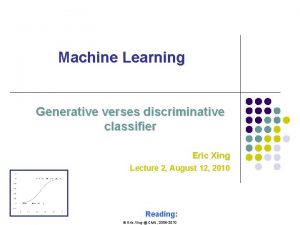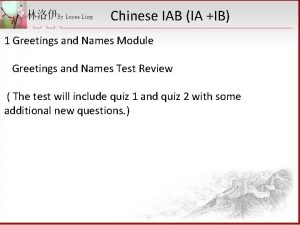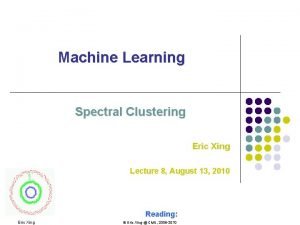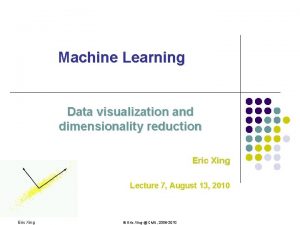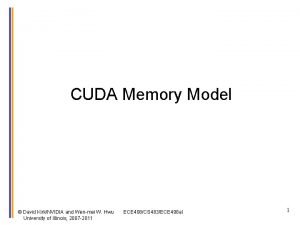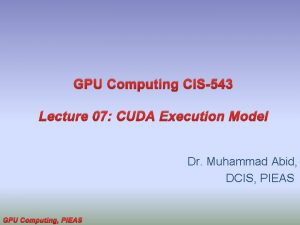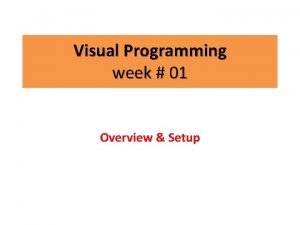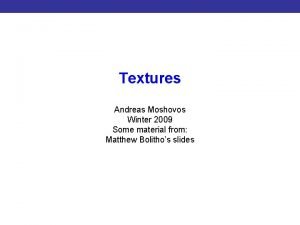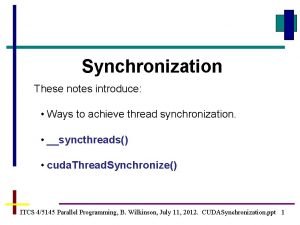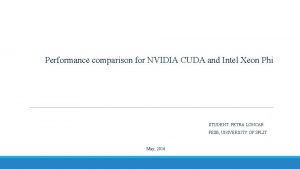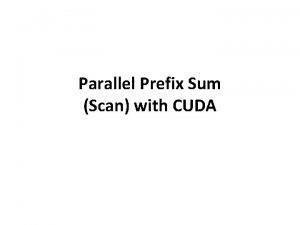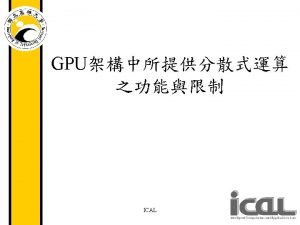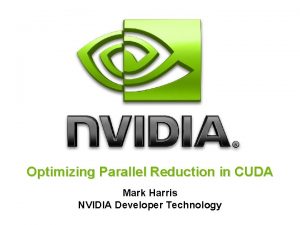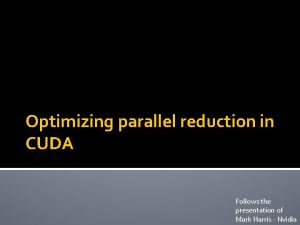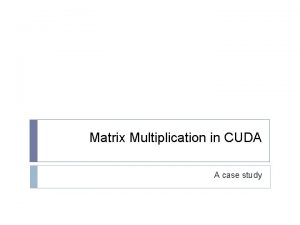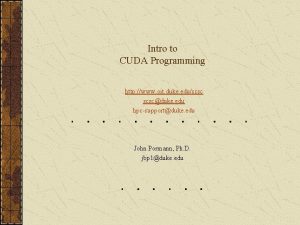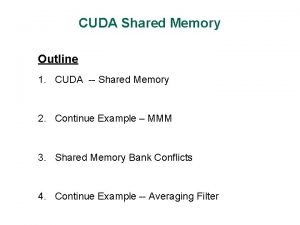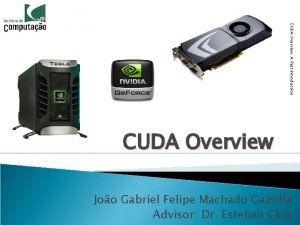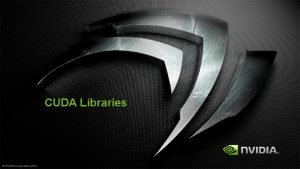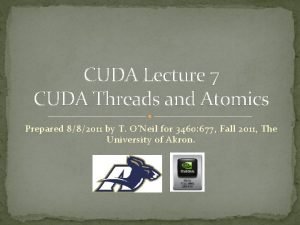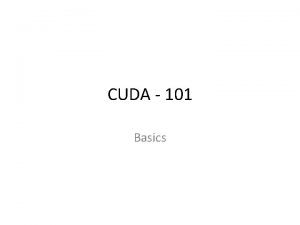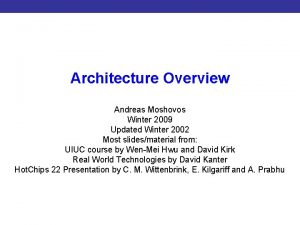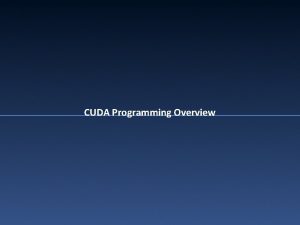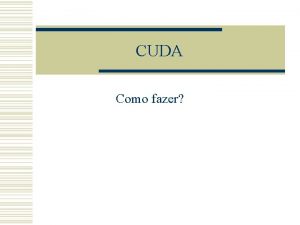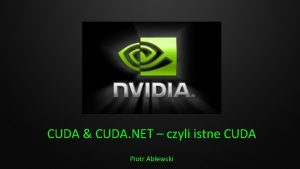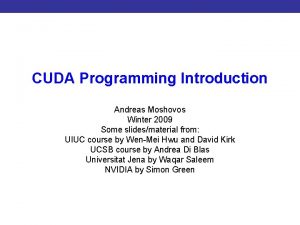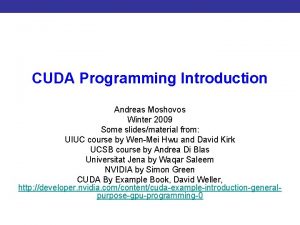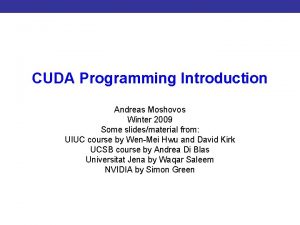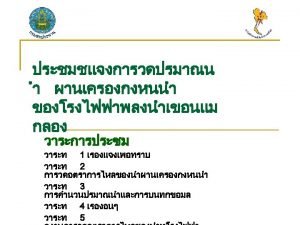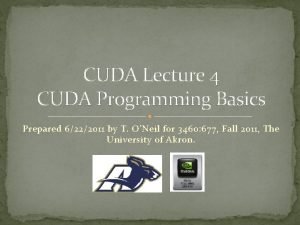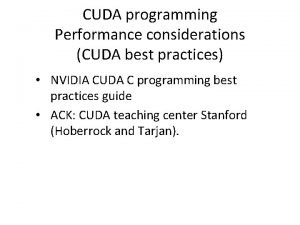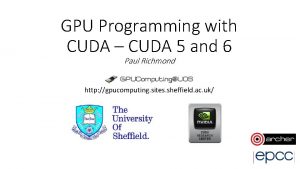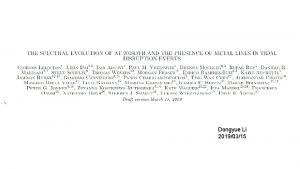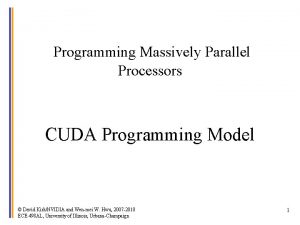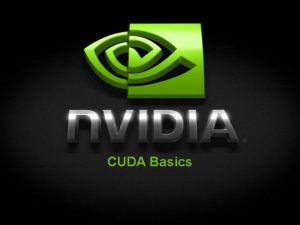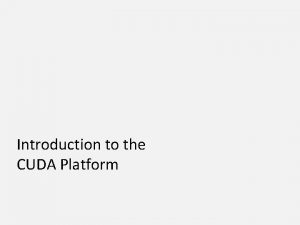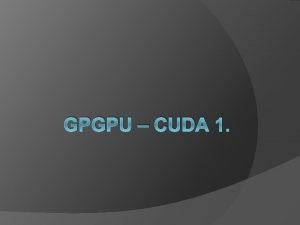CUDA Programming Model Xing Zeng Dongyue Mou Outline





















































![References [1] CUDA Programming Guide, n. Vidia Corp. [2] The CUDA Compiler Driver, n. References [1] CUDA Programming Guide, n. Vidia Corp. [2] The CUDA Compiler Driver, n.](https://slidetodoc.com/presentation_image/13252c9a4fb38925675cc856b2e8c566/image-54.jpg)

- Slides: 55

CUDA Programming Model Xing Zeng, Dongyue Mou

Outline • • Introduction Motivation Programming Model Memory Model CUDA API Example Pro & Contra Trend

Outline • Introduction • • Motivation Programming Model Memory Model CUDA API Example Pro & Contra Trend

Introduction What is CUDA? - Compute Unified Device Architecture. - A powerful parallel programming model for issuing and managing computations on the GPU without mapping them to a graphics API. • Heterogenous - mixed serial-parallel programming • Scalable - hierarchical thread execution model • Accessible - minimal but expressive changes to C

Introduction Software Stack: • Libraries: CUFFT & CUBLAS • Runtime: Common component Device component Host component • Driver: Driver API

Introduction CUDA SDK

Outline • Introduction • Motivation • • • Programming Model Memory Model CUDA API Example Pro & Contra Trend

Motivation GPU Programming Model GPGPU Programming Model CUDA Programming Model

Motivation GPU Programming Model GPGPU Programming Model CUDA Programming Model

Motivation GPU Programming Model for Graphics

Motivation GPU Programming Model GPGPU Programming Model CUDA Programming Model

Motivation GPGPU Programming Model Trick the GPU into general-purpose computing by casting problem as graphics • Turn data into images ("texture maps") • Turn algorithms into image synthesis ("rending passes") Drawback: • Tough learning curve • potentially high overhead of graphics API • highly constrained memory layout & access model • Need for many passes drives up bandwidth consumption

Motivation GPGPU Programming to do A + B

Motivation What's wrong with GPGPU 1 APIs are specific to Graphics Limited texture size and dimension Limited Instruction set No thread Communication Limited local storage Limited shader outputs No scatter

Motivation What's wrong with GPGPU 2

Motivation GPU Programming Model GPGPU Programming Model CUDA Programming Model

Outline • Introduction • Motivation • Programming Model • • • Memory Model CUDA API Example Pro & Contra Trend

Programming Model CUDA: Unified Design Advantage: HW: fully generally data-parallel archtecture. • General thread launch • Global load-store • Parallel data cache • Scalar architecture • Integers, bit operation SW: program the GPU in C • Scalable data parallel execuation/ memory model • C with minimal yet powerful extensions

Motivation From GPGPU to CUDA Programming Model

Programming Model Feature 1: • • Thread not pixel Full Integer and Bit Instructions No limits on branching, looping 1 D, 2 D, 3 D thread. ID allocation Feature 2: • Fully general load/store to GPU memory • Untyped, not fixed texture types • Pointer support Feature 3: • Dedicated on-chip memory • Shared between threads for inter-threads communication • Explicitly managed • As fast as registers

Programming Model Important Concepts: • Device: GPU, viewed as a co-processor. • Host: CPU • Kernel: data-parallel, computed-intensive positions of application running on the device.

Programming Model Important Concepts: • Thread: basic execution unit • Thread block: A batch of thread. Threads in a block cooperate together, efficiently share data. Thread/block have unique id • Grid: A batch of thread block. that excuate same kernel. Threads in different block in the same grid cannot directly communicate with each other

Programming Model Simple example ( Matrx addition ): cpu c program: cuda program:

Programming Model Hardware implementation: A set of SIMD Multiprocessors with On. Chip shared memory

Programming Model G 80 Example: • 16 Multiprocessors, 128 Thread Processors • Up to 12, 288 parallel threads active • Per-block shared memory accelerates processing.

Programming Model Streaming Multiprocessor (SM) • Processing elements o o 8 scalar thread processors 32 GFLOPS peak at 1. 35 GHz 8192 32 -bit registers (32 KB) usual ops: float, int, branch. . . • Hardware multithreading o o up to 8 blocks (3 active) residents at once up to 768 active threads in total • 16 KB on-chip memory • supports thread communication • shared amongst threads of a block

Programming Model Execution Model:

Programming Model Single Instruction Multiple Thread (SIMT) Execution: • Groups of 32 threads formed into warps always executing same instruction share instruction fetch/dispatch some become inactive when code path diverges o hardware automatically handles divergence o o o • Warps are primitive unit of scheduling • pick 1 of 24 warps for each instruction slot. • all warps from all active blocks are time-sliced

Outline • Introduction • Motivation • Programming Model • Memory Model • • CUDA API Example Pro & Contra Trend

Memory Model There are 6 Memory Types :

Memory Model There are 6 Memory Types : • Registers o on chip o fast access o per thread o limited amount o 32 bit

Memory Model There are 6 Memory Types : • Registers • Local Memory o in DRAM o slow o non-cached o per thread o relative large

Memory Model There are 6 Memory Types : • Registers • Local Memory • Shared Memory o on chip o fast access o per block o 16 KByte o synchronize between threads

Memory Model There are 6 Memory Types : • Registers • Local Memory • Shared Memory • Global Memory o in DRAM o slow o non-cached o per grid o communicate between grids

Memory Model There are 6 Memory Types : • Registers • Local Memory • Shared Memory • Global Memory • Constant Memory o in DRAM o cached o per grid o read-only

Memory Model There are 6 Memory Types : • Registers • Local Memory • Shared Memory • Global Memory • Constant Memory • Texture Memory o in DRAM o cached o per grid o read-only

Memory Model • Registers • Shared Memory o on chip • • Local Memory Global Memory Constant Memory Texture Memory o in Device Memory

Memory Model • Global Memory • Constant Memory • Texture Memory o managed by host code o persistent across kernels

Outline • • Introduction Motivation Programming Model Memory Model • CUDA API • Example • Pro & Contra • Trend

CUDA API provides a easily path for users to write programs for GPU device. It consists of: • A minimal set of extensions to C/C++ o o o type qualifiers call-syntax build-in variables • A runtime library to support the execution o o o host component device component common component

CUDA API CUDA C/C++ Extensions: • New function type qualifiers __host__ void Host. Func(. . . ); //executable on host __global__ void Kernel. Func(. . . ); //callable from host __device__ void Device. Func(. . . ); //callable from device only o Restrictions for device code (__global__ / __device__) § § § no recursive call no static variable no function pointer __global__ function is asynchronous invoked __global__ function must have void return type

CUDA API CUDA C/C++ Extensions: • New variable type qualifiers __device__ int Global. Var; //in global memory, lifetime of app __const__ int Const. Var; //in constant memory, lifetime of app __shared__ int Shared. Var; //in shared memory, lifetime of blocks o Restrictions § § no external usage only file scope no combination with struct or union no initialization for __shared__

CUDA API CUDA C/C++ Extensions: • New syntax to invoke the device code Kernel. Func<<< Dg, Db, Ns, S >>>(. . . ); o o Dg: dimension of grid Db: dimension of block Ns: optional, shared memory for external variables S : optional, associated stream • New build-in variables for indexing the threads o o grid. Dim: dimension of the whole grid block. Idx: index of the current block. Dim: dimension of each block in the grid thread. Idx: index of the current thread

CUDA API CUDA Runtime Library: • Common component o o Vector/Texture Types Mathematical/Time Functions • Device component Mathematical/Time/Texture Functions Synchronization Function o __syncthreads() o Type Conversion/Casting Functions o o

CUDA API CUDA Runtime Library: • Host component o Structure o Functions § Driver API § Runtime API § Device, Context, Memory, Module, Texture management § Execution control § Interoperability with Open. GL and Direct 3 D

CUDA API The CUDA source file uses. cu as extension. It contains host and device source codes. The CUDA Compiler Driver nvcc can compile it and generate CPU/PTX binary code. (PTX: Parallel Thread Execution, a device independent VM code) PTX code may be further translated for special GPU-Arch.

Outline • • • Introduction Motivation Programming Model Memory Model CUDA API • Example • Pro & Contra • Trend

Programming Model Simple example ( Matrx addition ): cpu c program: cuda program:

Outline • • • Introduction Motivation Programming Model Memory Model CUDA API Example • Pro & Contra • Trend

Pro & Contra CUDA allows • massive parallel computing • with a relative low price • high integrated solution • personal supercomputing • ecofriendly production • easy to learn

Pro & Contra Problem. . . • slightly low precision • limited support for IEEE-754 • no recursive function call • hard to use for irregular join/fork logic • no concurrency between jobs

Outline • • Introduction Motivation Programming Model Memory Model CUDA API Example Pro & Contra • Trend

Trend • • • More cores on-chip Better support for float point Flexiber configuration & control/data flow Lower price Support higher level programming language
![References 1 CUDA Programming Guide n Vidia Corp 2 The CUDA Compiler Driver n References [1] CUDA Programming Guide, n. Vidia Corp. [2] The CUDA Compiler Driver, n.](https://slidetodoc.com/presentation_image/13252c9a4fb38925675cc856b2e8c566/image-54.jpg)
References [1] CUDA Programming Guide, n. Vidia Corp. [2] The CUDA Compiler Driver, n. Vidia Corp. [3] Parallel Thread Execution, n. Vidia Corp. [4] CUDA: A Heterogeneous Parallel Programming Model for Manycore Computing, ASPLOS 2008, gpgpu. org

Question?
 Cuda programming model
Cuda programming model Cuda programming model
Cuda programming model Cuda programming model
Cuda programming model Cuda programming model
Cuda programming model Ccfir
Ccfir Hypothalamus hormones
Hypothalamus hormones Zhonggang zeng
Zhonggang zeng Marcia zeng
Marcia zeng Zeng rush
Zeng rush Eric xing
Eric xing Eric xing
Eric xing Eric xing
Eric xing Liudong xing
Liudong xing Eric p. xing
Eric p. xing Qing wen nin gui xing
Qing wen nin gui xing Pid xing
Pid xing Saklawnito ang pagsulat ng feasibility study.
Saklawnito ang pagsulat ng feasibility study. Nǐ xìng shénme
Nǐ xìng shénme Pestiential
Pestiential Nǐ guì xìng
Nǐ guì xìng Cmu machine learning
Cmu machine learning Eric xing cmu
Eric xing cmu Lle algorithm
Lle algorithm Dali
Dali Cal fire bargaining unit 8 mou
Cal fire bargaining unit 8 mou Signe mou
Signe mou Mou cz
Mou cz Http://mou
Http://mou Cuda memory model
Cuda memory model Cuda
Cuda Example of a quote sandwich
Example of a quote sandwich Ai2.appinventor.mit.edu emulator
Ai2.appinventor.mit.edu emulator Perbedaan linear programming dan integer programming
Perbedaan linear programming dan integer programming Greedy programming vs dynamic programming
Greedy programming vs dynamic programming System programming vs application programming
System programming vs application programming Linear vs integer programming
Linear vs integer programming Definisi integer
Definisi integer Cuda texture object example
Cuda texture object example Cuda texture memory
Cuda texture memory Cuda global synchronization
Cuda global synchronization Sedam svetskih cuda
Sedam svetskih cuda Nvidia cuda comparison
Nvidia cuda comparison Exclusive scan
Exclusive scan Rbg pixel
Rbg pixel Syncthreads
Syncthreads Reduction cuda
Reduction cuda Cuda code for matrix multiplication
Cuda code for matrix multiplication Alisa u zemlji čudesa
Alisa u zemlji čudesa Oit duke
Oit duke Cuda matrix multiplication shared memory
Cuda matrix multiplication shared memory Cuda overview
Cuda overview Cuda math library
Cuda math library Cuda atomics
Cuda atomics What is cuda
What is cuda Cuda architecture explanation
Cuda architecture explanation Apostrofa je
Apostrofa je
